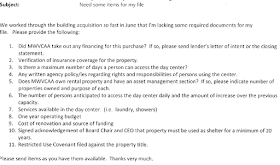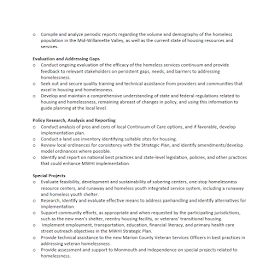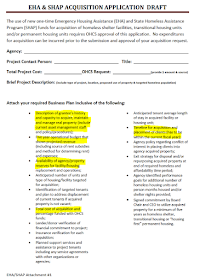Revised: January 2019
By Sarah Owens and Michael Livingston
Last October 2016, when OHCS changed its rules to allow CAAs to use their EHA and SHAP funds for acquisition, eight expressed interest. Four, however did not bother to apply. According to OHCS's August 30 memo, a major factor preventing their applying was "the short timeline to implement" -- they only had until June 30 to "complete the purchase and have ready for client use a shelter or transitional housing facility."
As discussed in Part 1, the short timeline somehow wasn't a problem for MWVCAA, who also didn't bother applying. Lucky for them, OHCS cleared their funds to be used for acquisition anyway. Let's say that was a mistake.
But, as we will show in Part 2, the mistake was eventually discovered. Unfortunately, rather than admit the mistake, OHCS and MWVCAA colluded to paper it over, so no one need know.
"Need some items for my file"
The first suggestion of record that OHCS knew they'd screwed up is an August 1 email to CRP Director Jimmy Jones.
I have to write something up on the acquisition accomplished with the EHA-NEW funds. Please tell me 1) what date MWVCAA completed their move and opened to the public in the new location, 2) what other funding was used to make the building purchase, and 3) what is your capacity for the day shelter.
Now, obviously, OHCS should have known the answers to these questions before they released the half million dollars of EHA and SHAP funds, because they go to the basic requirements of the funding.
And, just as obviously, Jones knew OHCS's questions went to the basic requirements of the funding, and knew what the answers needed to be in order to avoid the whole phony Golden ARCHES deal blowing up in everyone's face. Jones replied.
We completed the move on June 30th and opened immediately. We used [O]HCS dollars for our down payment, and completed a contract sale for the building with the owners. The payments are coming out of our normal operating budget (CSBG). The capacity for the day center will be 65 at any one time. Right now we've got enough money to substantially upgrade the day center area. The drawings are being finalized, and we're about to start a renovation that will allow us to run a real, one-stop shop, bring in medical and dental and other agencies to work with our population.
Trouble was, the answer to Question 1 needed to be that the day shelter was opened by June 30. However, the day shelter would not open for more than a year.
What could they do? It was too late. The money was spent. They did what anybody would do. They tried to cover it up. They lied.
OHCS, Jones, and MWVCAA all pretended that the office building or "day center" being "open to the public" was the same as its being a place where people experiencing homelessness could take shelter -- it wasn't, and it wouldn't be for over a year. It was a cruel, shameless, lie.
What could they do? It was too late. The money was spent. They did what anybody would do. They tried to cover it up. They lied.
OHCS, Jones, and MWVCAA all pretended that the office building or "day center" being "open to the public" was the same as its being a place where people experiencing homelessness could take shelter -- it wasn't, and it wouldn't be for over a year. It was a cruel, shameless, lie.
The answer to Question 2 needed to be consistent with the purchase's being completed by June 30. But, a "contract sale", sometimes called an "installment contract" is a seller-financed agreement to purchase a property over time. It is the antithesis of a completed purchase. Furthermore, OHCS's question shows OHCS had no idea how much MWVCAA had agreed to pay for the building, or what proportion of the facility was devoted to use as a "day shelter." As OHCS didn't know what other funding was used to purchase the building, it had no way to gauge the project's feasibility, when or if it was likely to be completed, or whether it was an appropriate of use of almost $.5M of EHA/SHAP funds. Furthermore, Jones's answer omitted any mention of the two, quarter-million dollar balloon payments, which could not be possibly be paid out of MWVCAA's "normal operating budget", and which OHCS should have questioned.
The answer to Question 3 needed to demonstrate that the Commercial Street facility had, since June 30, been continuously operating as a day shelter at a capacity that was substantially increased from its capacity on Madison Street. MWVCAA's hedging answer as to what the capacity "will be" begged the question what the current capacity was, namely zero. It would be more than a year before the day shelter could open.
Jones's assertions about having "enough money" "right now" for renovations, about "drawings...being finalized", and about renovations being "about to start" were lies.
On June 23, Jones indicated that he would be relying on grants to pay for renovations. September management reports indicate Jones was still waiting to hear whether they'd secured $125K in grants "for the day center", and that an architect had only just been secured to complete the needed drawings. So, the drawings could not have been "being finalized" on August 1. In consideration of Jones's "optimism", we gave his answer a "Mostly False", even though none of what he said was true in fact.
On June 23, Jones indicated that he would be relying on grants to pay for renovations. September management reports indicate Jones was still waiting to hear whether they'd secured $125K in grants "for the day center", and that an architect had only just been secured to complete the needed drawings. So, the drawings could not have been "being finalized" on August 1. In consideration of Jones's "optimism", we gave his answer a "Mostly False", even though none of what he said was true in fact.
About a week after that first set of questions, OCHS was back. "We worked through the building purchase so fast in June that I'm lacking some required documents for my file."
Someone at OHCS must have finally figured out that MWVCAA hadn't so much as submitted an application. So, why not admit the mistake?
Instead, OHCS acted as though they just happened to have a few, very pointed questions that just happened to cover what should have been provided with the acquisition application -- the one that MWVCAA didn't submit. Jones's response was prompt. "I'm working this, will try to have it all to you no later than mid-week of next week."
The next day, August 11, we published "MWVCAA Purchase Appears to Side-step State Approval Process", prompting this email to the Homeless Services Section manager from the staffer who worked on all the acquisition projects:
"There's one thing we can argue about the blog article: this project fits under the Community Capacity Building definition, which reads in part: Eligible expenses include programs, activities and projects that expand homeless prevention and or intervention program capacity."
"There's one thing we can argue"? Not, "Oh, s%$t. We're busted. They know MWVCAA never submitted an application. What do we do now?"?
Later that day, still August 11, the staffer sent Jones an acquisition application form with the directive, "Please provide as many documents as possible by Monday." (Emphasis added.)
Monday, Jones's responses started trickling in to OHCS. Some of the information was new, much of it had been conveyed in previous emails. Then came the closing documents, the accounting policies, the list of MWVCAA's real estate holdings. Tuesday, Jones made a special request.
Would it be possible to pull the installment note I sent yesterday out of the file? The reason I am asking is that there are two $250,000 balloon payments in there, that we are going to have to cover at some point. I'd rather that piece not be public knowledge if I can avoid it.
"That we are going to have to cover at some point"? Could it be any clearer that MWVCAA had no plan for making those balloon payments? And, what's more, they didn't care, and, apparently, neither did OHCS, because they didn't ask about them.
On August 16, OHCS told Jones they needed a signed document promising to use the property as a day shelter/center for 20 years (of course, MWVCAA was already in breach of that covenant, but, never mind), and a five-year operational budget. On August 23, Jones provided the requested document, and told OHCS, "Yes, we do have reserves and resources that could be used for operating and repairs as the need arises." No further assurances were offered or asked for.
At some point in late August, Jones provided OHCS an undated "business plan" for the project. But, whereas a business plan generally projects 3-5 years ahead and outlines the path and organization intends to take to reach its goals, including revenue projections, the document Jones submitted reads like bad advertising copy that fails to distinguish between aspiration and reality. It doesn't even call itself a plan. Here's a brief summary:
The Executive Summary: the old building was run down and we needed to move. The new building is in a better location and will allow us to expand. Organizational Statements: vision, mission, name, business form. Services: we're one day going to provide a whole bunch of services. Company History: CAAs were created as part of the War on Poverty. Market Analysis: (5 pages) there are a lot of homeless in Salem. Management Summary: there are 7 really amazing managers working on this project. Funding: ARCHES gets lots of $$ from OHCS, HUD/CoC, FEMA, HUD/HOME, CSBG, SSVF, OHA, and DHS, among others.
Financial Analysis (at left in its entirety) we have plenty of money for renovations and staff, but we're asking for more, just in case. Evaluation Tools: we have great assessment tools and are going to collect all kinds of cool data that will help us eliminate chronic homelessness in Salem. Growth and Grant Opportunities: "Our goal is to open the Day Center with full services in November 2017, with the hope of attracting most of the co-location partners quickly [within 2 years] after that."
Operational Budget: $14K/yr for supplies and equipment and $169K/yr for the building, not including the cost of hazard insurance or the $.5M in balloon payments due in 2018 and 2019. Income from Rents: (at right) $132K/yr.
Jones's projection that income from rents will eventually exceed the monthly mortgage payment by several hundred dollars was pure fantasy. Unless the City/County and local health care providers decide to put a sobering station on the first floor and pay MWVCAA substantial rent, but, when that might happen, and how long it would last, was anyone's guess.
In Part 3, the cost to the community, and the OHCS cover up.
Operational Budget: $14K/yr for supplies and equipment and $169K/yr for the building, not including the cost of hazard insurance or the $.5M in balloon payments due in 2018 and 2019. Income from Rents: (at right) $132K/yr.
Jones's projection that income from rents will eventually exceed the monthly mortgage payment by several hundred dollars was pure fantasy. Unless the City/County and local health care providers decide to put a sobering station on the first floor and pay MWVCAA substantial rent, but, when that might happen, and how long it would last, was anyone's guess.
"I can confirm that MWVCAA did have OHCS approval prior to acquiring the site"
In Part 3, the cost to the community, and the OHCS cover up.

























